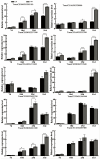Comparative Proteome and Weighted Gene Co-Expression Network Analyses Uncover the Mechanism of Wheat Grain Protein Accumulation in Response to Nitrogen Fertilizer Application
- PMID: 40361565
- PMCID: PMC12071265
- DOI: 10.3390/foods14091481
Comparative Proteome and Weighted Gene Co-Expression Network Analyses Uncover the Mechanism of Wheat Grain Protein Accumulation in Response to Nitrogen Fertilizer Application
Abstract
This study uses proteomic technology to identify differentially expressed proteins (DEPs) under varying nitrogen fertilizer levels. Additionally, it utilizes weighted gene co-expression network analysis (WGCNA) based on expression data of DEP-coding genes to explore the mechanism by which nitrogen promotes grain protein accumulation. The results indicate that high-nitrogen treatment leads to an increased grain protein content, wet gluten content, stability time, and energy area. In addition, the β-sheet content of the protein secondary structure increased, while the irregular curl content decreased. A total of 285 DEPs were identified under different nitrogen levels, with 172 upregulated proteins in grains under high-nitrogen treatment including storage proteins (8.14%) and proteins involved in nitrogen metabolism (8.72%), defense/stress (11.04%), regulation (26.16%), and transport (5.23%). This suggests that both storage proteins and certain metabolic proteins contribute to dough network formation. WGCNA revealed a strong correlation between the blue module and grain samples, and Gene Ontology analysis indicated that most genes were enriched in response to abscisic acid (ABA) in the "biological process" category. Furthermore, 18 core genes were identified, with most containing ABA response elements, light response elements, and motifs related to storage protein regulation in their promoter regions. Expression analysis of 10 genes and their predicted transcription factors during the grain-filling stage demonstrated higher expression levels under high-nitrogen conditions. This study provides valuable insights into the promotion of grain protein accumulation and dough quality by nitrogen fertilizer application.
Keywords: differentially expressed proteins; gene co-expression network analysis; grain protein accumulation; nitrogen fertilizer application level; wheat grain.
Conflict of interest statement
The authors declare no conflicts of interest.
Figures





References
-
- Kaur A., Shevkani K., Katyal M., Singh N., Ahlawat A.K., Singh A.M. Physicochemical and rheological properties of starch and flour from different durum wheat varieties and their relationships with noodle quality. J. Food Sci. Technol. 2016;4:2127–2138. doi: 10.1007/s13197-016-2202-3. - DOI - PMC - PubMed
-
- UthayakUmaran S., Wrigley C. Cereal Grains. Woodhead Publishing; Cambridge, UK: 2017. Durum Wheat: Grain-quality characteristics and management of quality requirements; pp. 135–151.
-
- Shewry P.R., Tatham A.S. Seed Proteins. Volume 2. Springer Netherlands; Dordrecht, The Netherlands: 1999. The characteristics, structures and evolutionary relationships of prolamins; pp. 11–33.
-
- Caballero P.A., Gómez M., Rosell C.M. Bread quality and dough rheology of enzyme-supplemented wheat flour. Eur. Food Res. Technol. 2007;224:525–534. doi: 10.1007/s00217-006-0311-3. - DOI
Grants and funding
LinkOut - more resources
Full Text Sources

